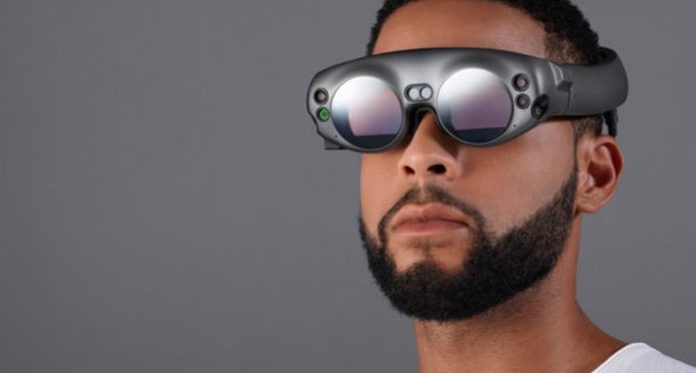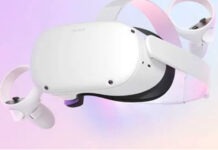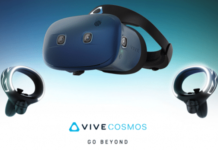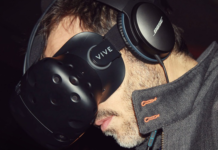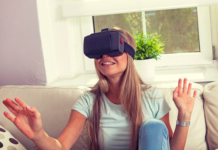Magic Leap has finally commercialized its “augmented reality” or “mixed reality” headset: the Magic Leap One. The American firm, based in Florida, aims to mix the virtual and the real. Developed since 2011 in the biggest secrecy, this device has managed to attract all investors in the high-tech industry. Discover all you need to know about Magic Leap and Magic Leap One, its mixed reality glasses announced as revolutionary.
Located in South Florida, the business park occupied by Magic Leap seems to be identical on board the many professional premises that are located throughout the suburbs of the United States. However, once inside, it’s more like another reality.
The television on the wall looks quite normal, until it suddenly disappears before reappearing a little later in the middle of the room, in full levitation.
This television seems real, but it is not. Like all the other illusions present in this business park, it is maintained by the lenses of the “augmented reality” headset (also called mixed reality) of the Magic Leap startup.
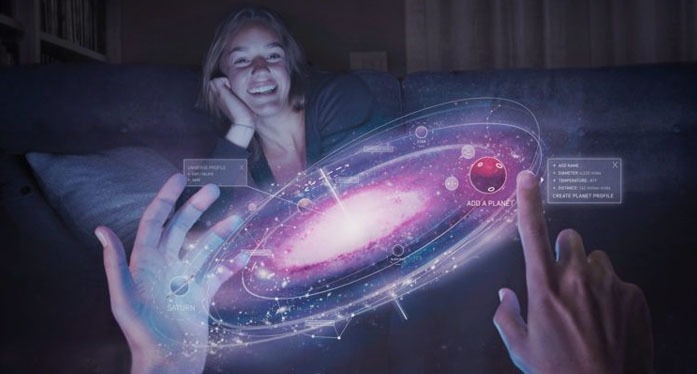 Magic Leap One glasses are out
Magic Leap One glasses are out
On August 8, to everyone’s surprise, Magic Leap announced the marketing of its mixed reality glasses the same day. It is thus August 8, 2018 that the first version of the eagerly awaited glasses is out. This is the Magic Leap One Creator Edition version intended primarily for developers wishing to create applications. Sold at a price of $ 2,295, the glasses were however available, for the moment, only in 6 American cities. A disappointment for many eager to test the glasses.
The first people who could test the glasses gave quite mixed opinions on the Magic Leap One. At the same time impressed by the colors and certain characteristics, they were however disappointed by the too limited field of vision of the glasses which limits the immersion . The prize has also been widely commented and criticized.
Magic Leap however ensures that future versions will be improved and different defects will be corrected. No it is not yet the expected WOW effect but it is very encouraging. All agree, however, that the quality of the images seen in the device is much better than those of the various videos presented so far.
The creator of the Oculus Rift massacre the Magic Leap One
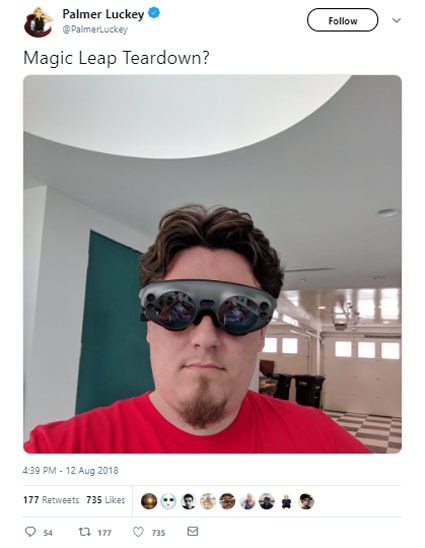 If the reviews of the journalists are mixed, the creator of the Oculus Rift, Palmer Luckey, was not tender with Magic Leap. According to him, the Magic Leap One is a “Tragic Heap”. He believes that this device is more worn by the hype developed over the years than by true substantial qualities.
If the reviews of the journalists are mixed, the creator of the Oculus Rift, Palmer Luckey, was not tender with Magic Leap. According to him, the Magic Leap One is a “Tragic Heap”. He believes that this device is more worn by the hype developed over the years than by true substantial qualities.
After dismounting the headset, Luckey believes in particular that Magic Leap has lied claiming to use a technology “light field” to give the impression to the user that the light comes into his eyes from different angles and fight against the phenomenon of nausea. In fact, the ML1 is based on the same technology as the 2016 HoloLens, which combines waveguides with LCOS displays and LED illuminations.
Palmer Luckey also criticizes motion-sensing control, which is too slow and even unusable near large steel objects. Likewise, the LuminOS operating system is only a modified version of the Android OS. He also deplores the impossibility of using the headset outdoors.
Despite these strong criticisms, Luckey salutes Magic Leap’s decision to separate the computer from the headset. He also believes that tracking technology is more successful than most other players in the RV / AR industry (with the exception of market leaders).
Yes, you can order a Magic Leap One Creator Edition
You may have looked at Magic Leap One with envy that the world is a little unfair. After all, the Magic Leap One is officially available right now in six US cities. For others, it will wait. Well, that’s in theory. This is especially so that the company expected not to be completely stormed but the Internet has already found a solution for that. Many companies already offer their delivery address services for those living in other countries. This is again the solution that is available.
The Magic-Leap Reality website reveals the possibility you have with the Big Apple Buddy Company based in New York. It functions as a concierge system. Specifically, you pay the cost of what you order plus shipping via DHL or FedEx and operating costs of $50 for the first item ordered. If you order more, the next ones cost only 15 dollars. Delivery is promised in just two days. However, this is probably not the case for Magic Leap since the company already announces 120 days to fill an order. 110 countries are affected including France you will understand.
Magic Leap has also made the choice to limit deliveries since the company adds a free delivery service for each order to a place at a chosen time. In theory, it also allows to have a little help to install the device. You will have to do without. Big Apple Buddy will do this with each delivery since it is an obligation but, with the documentation, it should not cause you too much trouble. Last pitfall, choose the right size according to your IPD. You can do this by downloading the Magic Leap application and have the right dimension. The technique is already working.
Magic Leap, the Mac of augmented reality
Since the first Magic Leap One were delivered, some have already had fun opening the bowels to see what was in the belly of the beast. Of course, it is those of the site iFixit, who launched themselves first. They were able to discover that this is really a very nice piece of technology. However, they also discovered that the repair could be very difficult or impossible.
Engineers who dismantled it also believe that left-handed people may have some interference problems at the time of use. To have a better eye-tracking, it will probably look down.
More worrying, the teams consider that it was “in a hurry” to arrive as quickly as possible on the market whatever the cost. It remains to be seen what will be its real life. We understand better in any case why its release date was a little uncertain. The “repairability” of the Magic Leap One is 3 on a scale of 10. That is roughly the level of the first iPhone.
When Magic Leap whale goes to reality
It was one of the visuals that made the buzz with Magic Leap. We are talking about beginnings, origins. A whale gushing out of an ocean located in a sort of big gym. A promise that made many users dream and probably gave rise to many investments in what was then only a promising start-up. It was a real promise of what could await us for the next level of augmented reality.
However, since then we have moved on to other things. Has different projects or critics like the director of the Oculus Rift, but now we can compare the original promise to the reality offered by Magic Leap. A comparison made possible with the Helio web application. It allows you to really see what gives a whale in your environment. Good of course, you will need some space. Do not try to get into your room.
If we are pessimistic, we can consider that the result is not really up to our expectations. However, one can also see things thinking that no one really believed that Magic Leap would keep its promises. From this point of view, the result is rather interesting. Note that Magic Leap also offers an angled e-commerce variation with the ability to change the color of a dress in two strokes. We let you test.
Magic Leap: the champion of the fundraising
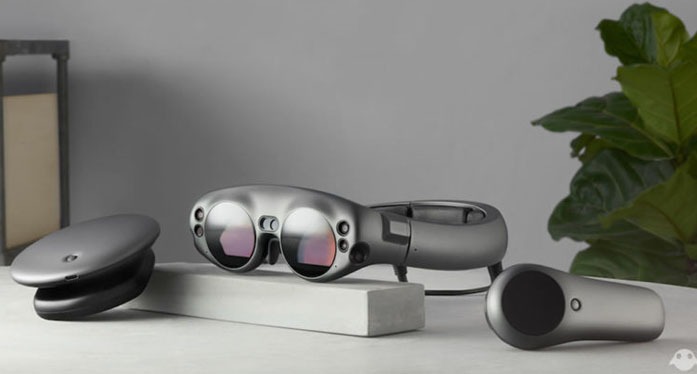 Despite this, huge sums of money were invested in this startup of Dania Beach, a small town of 30,000 people located south of Fort Lauderdale, Florida. In total, Magic Leap raised nearly $1.9 billion, including $794 million in February 2016 and $ 500 million in November 2017. This is the largest Series C fundraiser in history.
Despite this, huge sums of money were invested in this startup of Dania Beach, a small town of 30,000 people located south of Fort Lauderdale, Florida. In total, Magic Leap raised nearly $1.9 billion, including $794 million in February 2016 and $ 500 million in November 2017. This is the largest Series C fundraiser in history.
It seems like all the big tech companies share Magic Leap. Among the investors, we find, among others, Andreessen Horowitz, Kleiner Perkins, Google, JPMorgan, Fidelity, or Alibaba. Added to this list are other less conventional entities such as Warner Bros, or Legendary Entertainment, the producer of fashionable blockbusters. In its last funding, Magic Leap was valued at nearly $ 6 billion. If its founder owns even a quarter of the company, he is already a billionaire.
This avalanche of money has given rise to strange rumors within the tech communities. According to these corridor sounds, Magic Leap developed a technology related to holograms or lasers, or would have created a machine the size of a building, impossible to market, capable of altering reality . The lack of information fueled these murmurs and created a strange buzz around the Magic Leap name.
In fact, so far, the startup has never made any product demonstration in public, has never announced a product, and has never explained the proprietary technology “lightfield” used by its mysterious product . However, the company has finally decided to come out of the shadows.
Design of Magic Leap One Glasses
Since December 21, we finally finally know the design Magic Leap glasses. Called Magic Leap One, they are now pre-order on the Magic Leap official website. Although the datasheet is missing, it is known that Magic Leap One is supplied with a remote control and a tiny handheld extremely powerful to calculate and produce the graphical environment around the user.
Magic Leap One: a bold design
The first thing that comes to mind when discovering the design of the headset called “Lightwear” is the innovative side. Clearly, the device is unlike any other product so far. Of course, it takes up the general idea of what we could find with the Hololens. But, the choice of two separate glasses is daring. We are moving away from the single band that was law until then. It will be attached to a small box named “Lightpack” that looks like the old discman who succeeded the walkman before the first mp3 players. From a technical point of view, this is a mini laptop with a powerful graphics engine that will generate environments around the user. Users will also have a controller for navigation that includes a haptic feedback.
Above all, one of the benefits of this design could be in the field of vision. According to the first information, it would be more important than that of the Hololens. This criterion, which is clearly one of the most important when talking about augmented reality, is not detailed for the moment on the Magic Leap side. But, according to tests that have been done, including Brian Crecente Rolling Stone, we can already have an idea. He describes the FOV (field of view) as “the size of a VHS tape held in front of you with your arms half stretched. It’s wider than the Hololens. Not sure that this description is very clear to everyone. Above all, it is still only temporary.We already know that subsequent generations will increase this parameter.
Magic Leap One promises many applications
Magic Leap One for what? What are the uses that are mentioned for the moment? They are already multiple even if the device is at first thought as an accessory exclusively dedicated to professionals. On the power side, there is still a lack of information due to lack of technical data sheet. But, Rolling Stone magazine once again talks about ” the power of a MacBook Pro or an Alienware PC “. In the absence of more precise data, one can still be optimistic with these comparisons.
The first idea is to “pull the web off the screen”. Concretely, you observe an element in the real world and you visualize them in 3D to observe the details, to explore how you could modify it … A functionality that could for example be perfectly suited to the world of fashion or industrial design. The second possibility is the “Display on demand”. You could have multiple screens and offices simultaneously. A logic that also applies to the superposition of the real and the virtual. It is based specifically on the technology of digital Lightfield, “a photonic light field that generates digital light on different depths and blends perfectly with natural light ” explain Magic Leap.
Of course, the interaction between real and virtual is at the heart of the challenge. According to an idea proposed by the company, you could drop a virtual object on a real table and come back for it later. Finally, the gaming is of course also on the program, but it is not really a novelty. It remains to be seen what the headset can really bring innovative in this register compared to the competition. It may be through the realization of one of the promises of Magic Leap: “revolutionize the way to create “. But in this area, the change will undoubtedly come from users first and foremost.
In the course of 2018, a “Creator Portal” will be created to host the various projects of creators who have access to Magic Leap One. It will also provide access to tools and documentation to create applications in mixed reality. Above all, Magic Leap relies on the first users to imagine new uses that have not even been thought of until then. Ideas that could well be born in the social dimension of Magic Leap One. The company thus imagines workspaces in augmented reality.
Magic Leap One and the problem of security
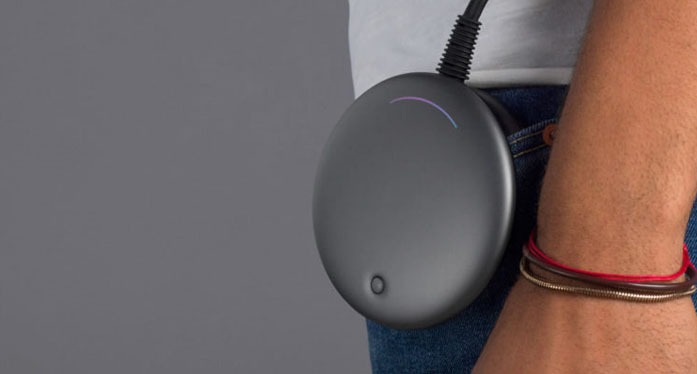 Of course, it is difficult in a time of technological innovation, connected objects or social networks not to worry about security issues, privacy. These issues are central to our uses today and it is largely for this reason that Google Glass augmented reality glasses were not successful at the time. Problem, for many specialists in the sector, Magic Leap One does not really respond appropriately to the questions asked.
Of course, it is difficult in a time of technological innovation, connected objects or social networks not to worry about security issues, privacy. These issues are central to our uses today and it is largely for this reason that Google Glass augmented reality glasses were not successful at the time. Problem, for many specialists in the sector, Magic Leap One does not really respond appropriately to the questions asked.
The basic idea of Magic Leap One is simple: add virtual objects to the real world. A lens that assumes cameras and microphones to be able to transcribe everything you see or hear. Either a huge and permanent data flow. We can therefore question the uses of these data. As “The Verge” points out, a Magic Leap patent mentions a partnership with Starbucks. Imagine the scene. You look at a Starbucks mug, the glasses detect where the nearest Starbucks is and offer you a drink. The same thing could happen in a supermarket with an automatic price comparator. The concept can be duplicable with power, a program on TV, what you ask the virtual assistant or even the applications you play. As long as we stop there, the prospects are dizzying. A feeling that grows when we think about the ability to track. Eye tracking sensors will know exactly where you are looking. Better than any other headset has done until today.
There is no guarantee that Magic Leap will misuse your data. But caution must be in order. First, because the company must win the trust of its users who have long been skeptical. As we know, Magic Leap has really thought intensively about the monetization of its product. Hard to believe that investors came to charity! But also because paradoxically, it is not a “big” company. The available means are not the same as for Google or Apple. The multiple security breaches that we have seen in recent years in innovative technologies such as connected objects should at least encourage caution. Finally, the company has also been at the heart of several controversies about the place of women in them with a very macho atmosphere. Not really the ideal mood to launch an inclusive accessory. But everything will depend on what users want to do…
Magic Leap One could be the new computer revolution
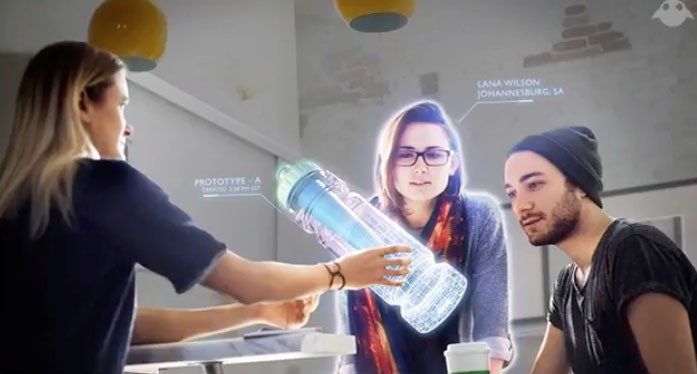 In one of the few interviews given by Abovitz, the CEO said Magic Leap spent $ 1 billion perfecting its prototype and started building production lines in Florida. A consumer version of its technology would soon be commercialized. When it arrives, which is expected in the coming months, this technology could usher in a new era for computing, a new generation of interface used in the coming decades.
In one of the few interviews given by Abovitz, the CEO said Magic Leap spent $ 1 billion perfecting its prototype and started building production lines in Florida. A consumer version of its technology would soon be commercialized. When it arrives, which is expected in the coming months, this technology could usher in a new era for computing, a new generation of interface used in the coming decades.
According to Abovitz, Magic Leap is developing a new type of contextual computer, something really different. The innovation of this startup is not only a high-tech screen. It is a totally disruptive machine. This technology could impact all businesses using screens or computers, and even those that do not use them.
This invention could kill the $120 billion flat-panel market and shake the $1 trillion global consumer electronics market. Its applications are deep, and could lead you to throw your PC, your laptop and your smartphone by allowing you to access all the computing power you need from a pair of glasses. These can bring up a screen of any size, anywhere.
In reality, these glasses can bring up anything and everything. For example, you’ll be able to see directions to a destination, in the form of yellow arrows printed directly on the road. You will also be able to see what the sofa will be like when you hesitate to buy it once in your living room, from all angles and all lighting conditions without having to leave your home.
Similarly, thanks to an interactive program highlighting the parts to replace, anyone will be able to repair a car and be alerted immediately if there is a mistake. Again, these are just examples. Yes, the Magic Leap apps are deep, and more than you can imagine.
The startup itself will benefit from all these interactions. Not only those based on the hardware and software it sells, but also the countless data it can collect, analyze and resell. For Abovitz, it is now difficult to think of an industry that will not be totally transformed by its technology. Magic Leap could take the place of Apple or Google as a master of technology.
 Magic Leap One faces an already fierce competition
Magic Leap One faces an already fierce competition
 Of course, Abovitz is far from being the only entrepreneur to perceive the opportunities of this sector. In the past 12 months, $2.3 billion has been invested in virtual reality and augmented reality, according to Digi-Capital. Similarly, International Data Corp says that global virtual reality and augmented reality revenue will grow from $5.2 billion in 2016 to $162 billion in 2020.
Of course, Abovitz is far from being the only entrepreneur to perceive the opportunities of this sector. In the past 12 months, $2.3 billion has been invested in virtual reality and augmented reality, according to Digi-Capital. Similarly, International Data Corp says that global virtual reality and augmented reality revenue will grow from $5.2 billion in 2016 to $162 billion in 2020.
Faced with such a prospect of growth, the big companies of this world covet their share of the pie. In 2013, Google tried to enter the augmented reality market with the Google Glass, a pair of glasses that can bring a screen in front of the eyes of the user. The project failed because of public concerns about privacy and security. However, Google’s massive investment in Magic Leap One demonstrates that the Mountain View firm is still interested in this technology. Google’s vice president of corporate development, Don Harrison, does not hide his willingness to help Rony and his team accelerate the realization of his vision in the real world.
Similarly, Apple is working on augmented reality. It is not known for now whether the Apple brand is developing an AR headset, or wants to add augmented reality features to the iPhone. In addition, Silicon Valley startups like Meta, who raised $73 million, or Atheer, with $23 million, are developing their own AR headsets.
In any case, for now, Magic Leap’s main competitor is none other than Microsoft, with its HoloLens headset announced in 2014. The pre-production version, HoloLens Development Edition, has already been sent to an unknown number of hardware and software developers last March. A commercial version should be available as early as 2017. According to analyst Brian Blau, of Gartner, Microsoft derives an important advantage from its prestige relations in the professional market.
 Now that production lines are in place, Magic Leap will enter “soon” on the market according to its creator. In 2016, the CEO of the company, without going into details about the price of the headset, the CEO said it would not be “a luxury product. ” However, in September 2017, Magic Leap announced that the headset will be released within 6 months of the announcement. It will only be available to a selected panel of consumers initially at an inexpensive price between 1500 and 2000 dollars. Magic Leap, however, has declined to comment on the subject for the moment.
Now that production lines are in place, Magic Leap will enter “soon” on the market according to its creator. In 2016, the CEO of the company, without going into details about the price of the headset, the CEO said it would not be “a luxury product. ” However, in September 2017, Magic Leap announced that the headset will be released within 6 months of the announcement. It will only be available to a selected panel of consumers initially at an inexpensive price between 1500 and 2000 dollars. Magic Leap, however, has declined to comment on the subject for the moment.
Magic Leap One will offer a new era for the entertainment industry
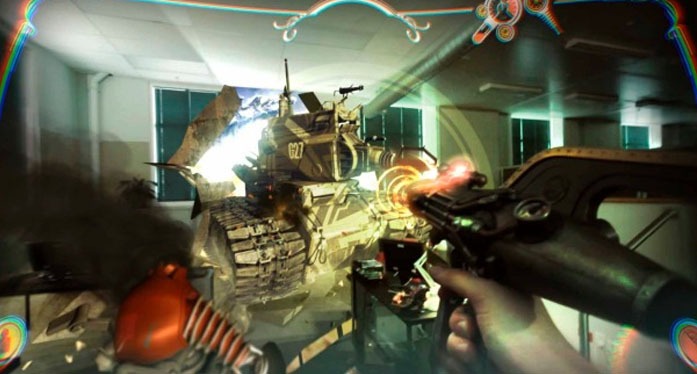 It is likely that Magic Leap One will primarily impact the professional sectors, including medical imaging and retail. Consumers will be able to try on clothes from home. However, as with most technologies, entertainment should lead the way.
It is likely that Magic Leap One will primarily impact the professional sectors, including medical imaging and retail. Consumers will be able to try on clothes from home. However, as with most technologies, entertainment should lead the way.
The bulk of Magic Leap content is developed internally, and the firm has already recruited several big names in video games. Designers, animators, artists and writers have joined the ranks of the firm as well as special effects stars. The author of Snow Crash, a science-fiction novel about virtual reality, Neal Stephenson, is developing a video game in the company’s Seattle office.
Similarly, 25 members of Weta Workshop work in a laboratory located in New Zealand. They develop the action game Dr. Grordbort’s Invaders, a title taking place in an alternative universe with a steampunk atmosphere . The player uses a laser gun to destroy evil robots trying to get through the walls of his living room.
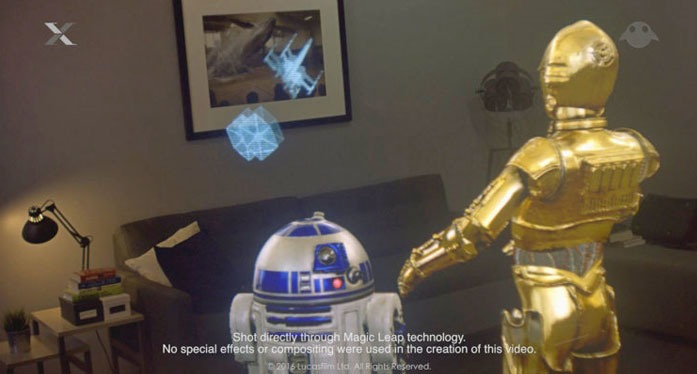 Last June, Magic Leap One also announced a partnership with ILMxLAB, Lucasfilm’s interactive entertainment division. A collaborative research laboratory has been opened on the Lucasfilm campus in San Francisco. This partnership has already generated several experiences of mixed reality in the universe of Star Wars. One of these experiments features C-3PO and R2-D2, and another transcribes the Battle of Hoth from the movie The Empire Strikes Back. The loop is complete for Rony Abovitz, the child who dreamed of building an X-wing.
Last June, Magic Leap One also announced a partnership with ILMxLAB, Lucasfilm’s interactive entertainment division. A collaborative research laboratory has been opened on the Lucasfilm campus in San Francisco. This partnership has already generated several experiences of mixed reality in the universe of Star Wars. One of these experiments features C-3PO and R2-D2, and another transcribes the Battle of Hoth from the movie The Empire Strikes Back. The loop is complete for Rony Abovitz, the child who dreamed of building an X-wing.
Doubts and fears around the Magic Leap One
As any business cultivating the absolute secret, Magic Leap One has been the subject of many rumors and fears have emerged when to the company’s technology. Many questioned the ability of the Florida company to miniaturize their technology to make it portable. Others thought that in terms of the manipulations and special effects used in the videos posted online that the company could never develop the technology of mixed reality as advanced. Yet, the very few people who could test the technology or all talked about something revolutionary.
Many people wondered why so many big companies were willing to invest huge sums of money in Magic Leap One if such doubts remained about technology and their ability to launch a product soon. The answer lies not so much in the product as in the patents filed by Magic Leap. Indeed, even if the company does not release any product or while it is a flop, investors would not be deprived. The patents and the potential of royalties related to their exploitation is colossal and is worth a very large part in the investments made.
Mixed reality, better than virtual reality and augmented reality
 Researchers at the University of Berkeley have been able to develop nanoscale components capable of diffracting light and choosing the desired color. Substructure bundles of different sizes are etched on silicon at very precise distances. The result is an ultra-thin, cheap and easy to mass produce component. By choosing the desired distance, only the desired color is reflected.
Researchers at the University of Berkeley have been able to develop nanoscale components capable of diffracting light and choosing the desired color. Substructure bundles of different sizes are etched on silicon at very precise distances. The result is an ultra-thin, cheap and easy to mass produce component. By choosing the desired distance, only the desired color is reflected.
The components allow you to project the desired shapes and colors and to display virtual 3D objects or holograms in the user’s environment. This technique was already used for anti-glare systems of some glasses but these were very limited in the desired angle. Note that these components can, moreover, find other applications such as creating an invisibility cloak and hide objects or projecting holograms .
In the last 12 months, companies like Google, Sony, Samsung and Facebook have all launched their virtual reality headset. It is likely that you have tried one of these devices. The VR is an immersive simulation generated by a computer, mainly used in video games. VR headsets hide and replace the real world.
You may have also tried augmented reality, offering to overlay digital content to the physical environment. In July 2016, Niantic Labs’ Pokémon Go app democratized this technology, making it the fashion of the summer. This game uses the cameras of smartphones to make appear on the screen small animated monsters superimposed on the real world.
However, no game in VR, no title like Pokémon Go can pretend to do what offers the mixed reality of Magic Leap. Virtual reality takes you into another environment, and augmented reality brings virtual content to the real world. The mixed reality, meanwhile, truly gives life to these virtual items.
This technology is mainly based on an HMD headset. However, the end product could be a simple pair of glasses. When the camera is worn, the view of the real world is not obstructed. An image is projected directly on the retina of the user thanks to an optical system integrated into a semi-transparent glass. In short, this system reproduces the way we observe the real world. In addition, the machine constantly collects information, scans the room to avoid obstacles, listens to the wearer’s voice, follows eye movements and looks at his hands.
As a result, objects of augmented reality are aware of their environment, and one’s ability to interact with the real world. On the Magic Leap headset, a Pokémon could avoid capture by hiding behind the couch or even turning off the lights of the connected house.
 In one of the demos presented by the Magic Leap team, we discover an “interactive virtual human”. This life-sized creature is incredibly realistic. Abovitz and his team have imagined virtual beings capable of performing the role of digital assistants like Siri, with more physical presence for better interactivity. This virtual assistant could for example be sent to deliver a message to a colleague wearing a Magic Leap headset.
In one of the demos presented by the Magic Leap team, we discover an “interactive virtual human”. This life-sized creature is incredibly realistic. Abovitz and his team have imagined virtual beings capable of performing the role of digital assistants like Siri, with more physical presence for better interactivity. This virtual assistant could for example be sent to deliver a message to a colleague wearing a Magic Leap headset.
In this world of mixed reality, computing power is no longer confined to a desktop device. It can be associated with any real or virtual object and give it an awareness of its location, purpose and how you want to use it. According to Abovitz, the whole world will become your office. If this technology keeps its promises, it could be the next state of the computer, after the PC and mobile devices.
According to Thomas Tull, founder of Legendary Entertainment, this technology is not limited to entertainment or video games. This is a new way of interacting with the world, a new generation of computers. The billionaire is convinced that Magic Leap One will become a “very, very important” business.
Rony Abovitz, the story of a child fascinated by science fiction
 Rony Abovitz was born in 1971 to Israeli parents living in Cleveland. All his childhood, he remained fascinated by computers and science fiction. According to his own words, he is a child of Steve Jobs and George Lucas. He dreamed of being Luke Skywalker, destroying the Death Star and building C-3PO.
Rony Abovitz was born in 1971 to Israeli parents living in Cleveland. All his childhood, he remained fascinated by computers and science fiction. According to his own words, he is a child of Steve Jobs and George Lucas. He dreamed of being Luke Skywalker, destroying the Death Star and building C-3PO.
At the age of 11, his family moved to South Florida. He starts high school at age 13, one year ahead. Once graduated, he is accepted at MIT, but chooses to study at the University of Miami to stay close to home. He received a bachelor’s degree in mechanical engineering in 1994 and a master’s degree in biomedical engineering in 1996. Then, he starts thinking about Star Wars again.
In 1997, he co-founded his first company, Z-KAT. His plan was to create the Star Wars medical droid, because he could not build an X-wing. Indeed, he could not have explained to his parents his desire to create a battleship after his brilliant studies.
In 2004, the robotics division of Z-KAT creates a new company. Called Mako Surgical, the firm will create robotic arms to help doctors during orthopedic operations. Demand is high, and the company raises $51 million in 2008.
Married, a little girl’s dad, Abovitz works full-time for Mako. To satisfy his creative inclination, he sets out to create a fictional universe, a project called Hour Blue. This imaginary world is an extraterrestrial planet populated by fantastic creatures such as humanoid robots and flying whales. In 2010, he launched a new company, Magic Leap Studio, to develop this project in the form of a series of comics and movies.
At the time of its creation, this company of which he is the only employee is limited to his garage. His mother sticks colorful letters on a canvas: “Magic Leap Studios”. To finance his project, he uses the money he saved while working for Mako, and recruits Weta Workshop, the New Zealand special effects specialist, known for his work on The Lord of the Rings trilogy. The role of Weta Workshop is to develop an imagery based on his story ideas to bring this fictional universe to life.
 At the same time, inspired by science-fiction novels such as William Gibson’s Neuromancer or Vernor Vinge’s Rainbows End , Abovitz feels frustrated that the virtual and augmented reality fantasized by writers still does not exist in the world real . He is thinking of a way to fix the problem.
At the same time, inspired by science-fiction novels such as William Gibson’s Neuromancer or Vernor Vinge’s Rainbows End , Abovitz feels frustrated that the virtual and augmented reality fantasized by writers still does not exist in the world real . He is thinking of a way to fix the problem.
According to Richard Taylor, CEO of Weta Workshop and a member of Magic Leap’s Board of Directors, it is at this very moment that reality and science fiction have begun to merge. The fictitious technologies imagined for Hour Blue were developed in parallel for real-world augmented technology applications that Rony was beginning to explore.
In 2011, Magic Leap Studio becomes Magic Leap Inc. Abovitz recruits a small team to help him develop his idea of mixed reality. In a short time, the company has functional prototypes. When the first removable pixel in space finally appears, the Magic Leap teams are over-excited. They know that this simple point means that the technology will work.
Abovitz also understands that he is going to need a lot of money. The firm was originally founded with Mako’s money. Following the acquisition of the company in 2013 by Stryker Corp, for $1.7 billion, a few million additional dollars were invested. However, this sum will not suffice.
Fortunately, the technology sold itself. Each person seeing Magic Leap with their own eyes can hardly believe what the company has actually achieved. All want to immediately invest in this ambitious revolutionary project .
 In February 2014, Magic Leap announced that it raised more than $ 50 million from private investors. Eight months later, a series B fundraiser, led by Google, brings $ 542 million to the company. James Joaquin, of Obvious Ventures, an investment arm based in San Francisco, co-founded by Evan Williams of Twitter, says he has invested in the project because he believes LightField technology will be the next inflection point after the PC, the web and the smartphone. This technology has the power to transform many global economic categories including entertainment, education and productivity.
In February 2014, Magic Leap announced that it raised more than $ 50 million from private investors. Eight months later, a series B fundraiser, led by Google, brings $ 542 million to the company. James Joaquin, of Obvious Ventures, an investment arm based in San Francisco, co-founded by Evan Williams of Twitter, says he has invested in the project because he believes LightField technology will be the next inflection point after the PC, the web and the smartphone. This technology has the power to transform many global economic categories including entertainment, education and productivity.
In February 2016, Magic Leap broke all records with a Series C fund raising $794 million. Led by Alibaba, this event also brings together Google, Qualcomm Ventures, Fidelity Investments, JPMorgan, Morgan Stanley and T. Rowe Price. According to Thomas Tull, a real frenzy is born around Magic Leap.
Magic Leap: A Gigantic Campus at Plantation, Florida
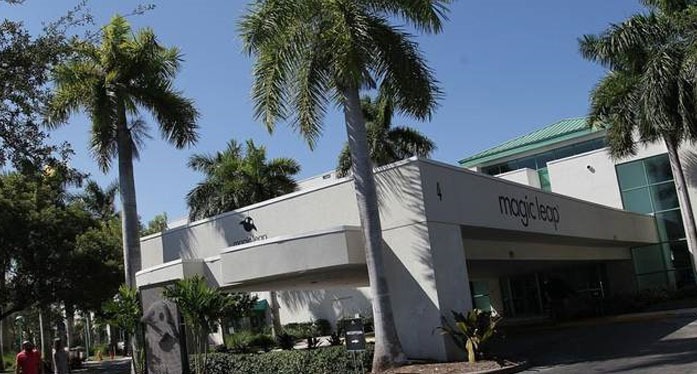 At first sight, Rony Abovitz does not look like an “industry captain”. While visiting the new headquarters of his firm, located in Plantation, Florida, the man admires the machines he describes as “cool”, contemplates the tools, jokes with the guests. Friendly, enthusiastic, dressed in jeans and a sweatshirt, the business leader is known for being as nice as he is intelligent.
At first sight, Rony Abovitz does not look like an “industry captain”. While visiting the new headquarters of his firm, located in Plantation, Florida, the man admires the machines he describes as “cool”, contemplates the tools, jokes with the guests. Friendly, enthusiastic, dressed in jeans and a sweatshirt, the business leader is known for being as nice as he is intelligent.
The new headquarters has been on since October 2015 for more than 24 square kilometers. By the end of the year, the majority of the firm’s 850 employees will come to work here. The remaining troops are separated in nine offices around the world, including Silicon Valley, Austin, Wellington, Tel Aviv and New Zealand. Several teams of engineers are already on site. It is important, in Abovitz’s eyes, to keep the teams of developers together as part of an “agile hardware” model, which has already produced hundreds of iterations of its prototype headset.
 The company also builds factories on the Plantation campus. These modular bays, aligned as submarines in a harbor, are described by Abovitz as the “spaceship” part of the company. Each production line can be activated as needed, producing thousands or millions of units per year depending on demand.
The company also builds factories on the Plantation campus. These modular bays, aligned as submarines in a harbor, are described by Abovitz as the “spaceship” part of the company. Each production line can be activated as needed, producing thousands or millions of units per year depending on demand.
The CEO wants Magic Leap to stay in Florida. One of the advantages of on-site production is to allow the firm to keep its secrets. In Northern California, that would be impossible. The rumor mill in Silicon Valley is way too well oiled. Of course, this location would allow the firm to recruit more easily. But the technology of this company is able to attract engineers and other talents from all over the world, in very large quantities.
Hololens, Meta 2 or Magic Leap One: what is the best augmented reality headset?
Hololens, the pioneer of augmented reality by Microsoft
We can answer the big question right away. At present, the Hololens is without much doubt, the most promising headset on the market of virtual reality. A domination primarily due to the advance made by Microsoft in this area. Only the very big high-tech company to position itself on this segment for the moment (Apple for example favors the augmented reality mobile), it opens the voice for others who want to participate in this market. If the two other models put forward here are the exception, since they are advanced in parallel, the Hololens remains a reference for the other market players.
Why this domination? There is a sensible part of marketing in this situation that cannot be ignored. But, it’s also the first real equipment that did not need to be connected to a computer to work. It realizes in real time with its sensors and cameras a 3D map of your environment to project realistically elements. So you can actually make real and virtual interact. Being a pioneer gives Microsoft a real head start from a software point of view with the Windows Mixed Reality ecosystem.
Meta 2, the alien in augmented reality of crowdfunding
The Meta 2 is a little incarnation of the digital revolution applied to augmented reality. This project made possible thanks to crowdfunding in 2013 announced its second version at the beginning of last year. We still miss a little perspective to evaluate what is really worth The Meta 2 which has finally been sent to developers in recent months. However, we already know that it is very different from the other two models in our selection, including a physical point of view. Indeed, it needs to be connected to a conventional computer to work. Forget the idea of moving into your home to enjoy. Its designers really imagine it as the replacement of your classic screens.
The screen is the real highlight of the device since it offers a 90 ° FOW. In short, almost three times that of the Hololens. What truly benefit your environment? As for the Hololens, it is mapped with sensors and cameras, but the possibilities of interactions are increased with the ability to grab virtual objects and move them more or less naturally.
His profile really different from his two competitors is also reflected in its price and that is why it could interest some users. The developer kit is currently sold at a price of $1500. Definitely much more accessible and consumer oriented. Unfortunately, Meta went bankrupt early in 2019…
Magic Leap One, from the hype to the child prodigy?
This is the project that is dreaming since the longest no doubt. We have been waiting for the Magic Leap since 2011. Increasingly impressive videos have followed one another at the same pace as the challenges. For many, it was just a scam. But investors in Silicon Valley continued to pour in. Finally unveiled recently Magic Leap One glasses should not really arrive on the market before the end of 2018.
However, the information available already makes it possible to make an opinion. Already, the choice of a portable graphics engine, the Lightpack that makes the headset both connected and portable. Especially the device looks much smaller than the competitors. As you will have noticed, we are talking about glasses and not headphones. A distinction of size that should especially be felt in terms of weight. But, that could also have consequences from an accessibility point of view. What about those who want to use Magic Leap One but who wear glasses? The equation could be complex.
The features that are announced clearly intend the headset for professional use for now. With particular uses for developers or the ability to create a virtual office. However, the large share left to gaming and especially its price should be strong arguments. Magic Leap One should indeed be marketed more or less at the same price as the Meta 2.
The latest information around the Magic Leap One
Magic Leap acquires the Belgian startup Mymesis and its holograms
In early May 2019, Magic Leap announced the acquisition of the Belgian startup Mymesis. The latter has developed a system for making video calls in 3D volumetry on the augmented reality headset. A technology presented at CES 2019, reminiscent of the famous Star Wars holograms that seems to have seduced the Florida-based AR giant.
With this system, it is possible to view a 3D representation of its interlocutor during a video call. The sensation of presence and realism is greatly increased, and holograms could well represent the future of communication…
Mimesys technology is originally based on Intel RealSense cameras that capture images while calculating depth, then assemble them on a PC and stream them to the user’s headset. However, the solution is not yet perfect and the holograms of the startup are cluttered with “noise”. However, Magic Leap may be considering creating their own depth-detection cameras to make it easier for corporate customers to create content. The new 5G mobile network should allow it to transmit images faster and more stably…
For now, the cost of this acquisition is unknown. Mymesis joins Magic Leap, but will continue to serve its corporate clientele made up of big names like BNP Paribas or Orange.
The Magic Leap One OS is named Lumin
The study of US Patent and Trademark Office (USPTO) publications can sometimes make good surprises as revealed by the website Next Reality. They were able to discover a trademark application in early January by Magic Leap in the name of “Lumin”. According to them, this would be the name of the operating system for the Magic Leap connected glasses.
The request made on January 18 refers to a “computer operating system “ . But why this certainty that this is the OS for Magic Leap? No doubt because of the clues already left by the company for other parts of its future system. We had Lightwear for the headset or Lightpack for the laptop. Now, Lumin looks a lot like Lumen, the Latin word for Light. While this may sound a little far-fetched, given the Magic Leap story, it might not be so surprising. The answer will probably come in a few weeks or months when the version for the creators will finally arrive on the market.
Magic Leap One and augmented reality music
This is a registry in which we did not expect Magic Leap. The company focused mainly on the visual aspect during the promotion phases. But, it seems that his ambition does not stop there. The company would work on an augmented reality music application with the Icelandic band Sigur Ros. The idea being of course to integrate Magic Leap at one time or another. In preparation for several years, the project has begun to emerge recently.
Of course, it’s a positioning that seems almost logical. If Magic Leap is now focusing attention on its equipment advertised as revolutionary, it will not serve much if it cannot also rely on high-level content. It’s a journey that had already begun in 2016 as part of a partnership between Lucas Films and Magic Leap. We had discovered R2-D2 and C3-PO in augmented reality in our living room.
But the project with this Icelandic group would go much further this time. In any case what announces the group in a post on the Instagram network. “After four years in secret, we are very excited to finally publicly announce our relationship with Magic Leap. Today, we are still at the beginning of this project which has unlimited potential from a point of view of fun and creativity. Thanks to Rony Abowitz (the CEO of Magic Leap) and his amazing team for bridging the future. ” The project will specifically take the form of an application called Tónandi. A word that can be translated as “the spirit of sound”. It would modify the music by interacting with forms in augmented reality.
Axel Springer, a newspaper publisher, invests in Magic Leap
So what does a German press publisher do to invest in an augmented reality group? This is the main issue for many players in the sector since the announcement on February 12. The media group (Bild, Die Welt but also Télé Magazine, Marmiton.org or aufeminin.com) in France did not reveal the amount of its investment. However, it is normally in the D series which was completed in October 2017.
In a press release, the group Axel Springer explains that Magic Leap represents a good opportunity when you want to produce and consume journalistic content or classified ads in innovative formats and environments. The financing transaction was carried out through Axel Springer Digital Ventures. A structure that has already distinguished itself in particular through investments in companies such as Uber or Airbnb. But in the same way, it is difficult to distinguish what the concrete benefits or the synergies envisaged by the media group will be. But maybe we will have the right to new surprises Magic Leap.
Other financiers, Axel Springer joined giants like Google, Qualcomm, or Warner Bros. In total, more than $2 billion has been raised by Magic Leap since the company emerged from the shadows in 2014.
Surprising Magic Leap Patent for LightPack
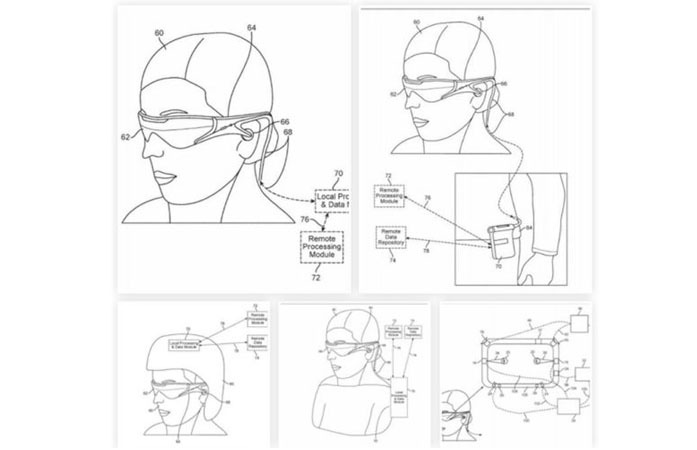 We talked about it as early as December. Among the end-of-year surprises related to Magic Leap One: Creator Edition, we found this famous little laptop to which glasses would connect. Code name: Lightpack. But, it seems that Magic Leap has not yet unveiled all its game if we believe a patent that has just been revealed by our colleagues in Next Reality.
We talked about it as early as December. Among the end-of-year surprises related to Magic Leap One: Creator Edition, we found this famous little laptop to which glasses would connect. Code name: Lightpack. But, it seems that Magic Leap has not yet unveiled all its game if we believe a patent that has just been revealed by our colleagues in Next Reality.
Until then, it was thought that it was mainly a source of food. But this patent, which goes back as far as July 31, 2017, describes a system that is able to measure distances through a light source to project a ray of light in augmented and virtual reality environments. This concept uses three units of measurement of inertia (IMU). The first two located at the level of your face can calculate the position of the head. The third measured at the level of your height, determines the position of the rest of the body.
What is it going to do concretely? To measure the direction in which the headset is pointing. As a result, where with a degree of tolerance of 0.2 to 0.6 dioptres of the optical plane the content must appear. The sketch published with the patent is also worth a look, although it is still unclear whether it is a simple scheme or a real visual project for Magic Leap.
Magic Leap announces a partnership with the NBA
As part of the Media Conference Code of February 13, 2018, Magic Leap CEO Rony Abovite and NBA Representative Adam Silver announced a partnership. Through this alliance, basketball fans will be able to enjoy their favorite sport in augmented reality. A promotional video with former superstar Shaquille O’Neal was aired.
Few details have been revealed, but Magic Leap explains that users will be able to follow basketball games with data and information superimposed. Thanks to the volumetric capture, players can even appear in full size in the middle of your living room. At the headset launch, a selection of the best recent or historic NBA games will be available. The highlights of the different players or teams will also be offered on request. Subsequently, live matches will be offered.
Magic Leap massively preparing for his arrival in the stores?
Sometimes, to know how a company is going, it is not on the side of the economic results or patents that must be looked at. But, job offers! This is the little surprise of the day with Magic Leap.
For the moment, we still have the impression that Magic Leap is a sort of chimera that is not ready at all for the market. Moreover, the first version called “Creator Edition” is not intended for the general public. But that does not stop Rony Abovitz from planning the future … far from it.
“Store Design Manager”
Of course, this is not yet the position of salesmen or department manager. Magic Leap is still far from reaching this level. The start-up talks in its job posting of “Store Design Manager” for the title of this job, a position that would be based at the company’s headquarters in Florida. The idea seems to be to imagine the very concept where Magic Leap would eventually be sold. Are we going to see the arrival of Magic Leap Store like the Apple Store? The idea seems to be somewhat different. According to the description, the company seems to want to privilege demonstration spaces in existing outlets.
This could be in the form of pop-up store as could Instagram to promote his glasses or stands installed in the gigantic “American malls”.
A sales concept that remains to be imagined
But, to tell the truth, the fact that this offer is unveiled as well is also revealing the path that remains to be traveled for the company. It almost seems to mean: we’re on the road, but we still have to imagine how to sell our product.
Because, that’s where the real challenge for Magic Leap finally lies. Imagine a sales experience that allows customers to hang in a moment. This is undoubtedly why the company’s offer refers to a “spatial experience”. Selling augmented reality glasses efficiently requires two imperatives. First and foremost, the place must first and foremost be a classic, attractive and intriguing sales area. The attraction of the novelty could quickly run out of steam with a minimum introductory price announced at $ 1000. We must also think of the place from a point of view of augmented reality.
That’s what Microsoft did last year for the Hololens for example. It was, however, a conference, the company did not have a direct sales ambition. Suffice to say that the employee who might have to travel 75% of the time according to the offer, will have a lot of work to do!
A patent allows you to know more about the Magic Leap One mount
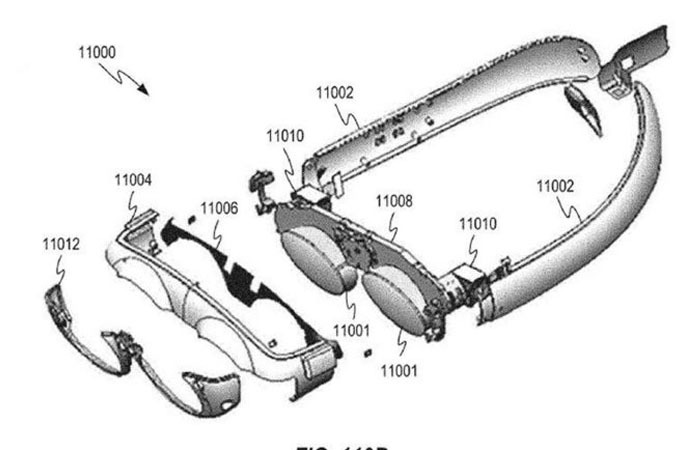 It’s the magic of the patent world. To protect themselves with their innovations, companies are forced to reveal themselves somewhat. This is what is happening today with Magic Leap. The US Patent and Trademark Office allows us to learn more about what’s happening with Magic Leap One: Creator Edition.
It’s the magic of the patent world. To protect themselves with their innovations, companies are forced to reveal themselves somewhat. This is what is happening today with Magic Leap. The US Patent and Trademark Office allows us to learn more about what’s happening with Magic Leap One: Creator Edition.
The first document titled “Systems and methods of virtual reality, augmented and mixed” contains for example many images to know what to expect for Lightwear, LightPack and controllers. Good news, there does not seem to be any difference with the images shown at the end of last year. This means that it is a close version of the definitive.
Another patent focuses on Magic Leap’s “waveguide” through a “multilayer diffractive eye” device. The images would be projected into the user’s eye through a waveguide coupled to a reflector that selects on the wavelength. The array then directs the light from the waveguide in two different directions.
At the same time, the reflector, bounces a portion of the light from the second direction to the first. The patent also describes an eye-level accessory with three such components to create three ranges of wavelength. Each wavelength corresponds to a different color (red, blue, green) and allows you to create holograms with three different levels of fields. They are technically diffused in two fields and the mixture between the two makes it possible to give the illusion of depth. If the explanation is particularly technical, the first tests should allow to know more.
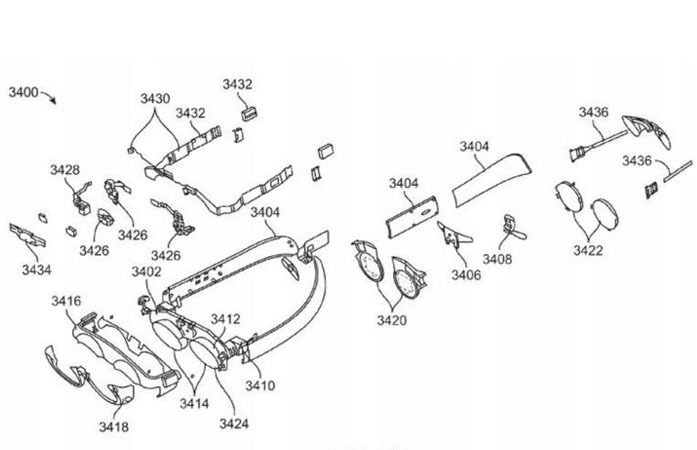 Magic Leap’s security chief reportedly attempted to extort millions of dollars from the company
Magic Leap’s security chief reportedly attempted to extort millions of dollars from the company
This is a somewhat surprising announcement but confirms that Magic Leap takes precautions. The company has just asked a Texas court to confirm that it did not discriminate against Todd Keil, its security chief. According to the document published by our colleagues from the American newspaper “The Verge”, the man was preparing to file a complaint. He would like to accuse the company of age discrimination but also to have broken the law on whistleblowers.
For its part Magic Leap accuses the man of not understanding the regulations of the market, not to go to meetings at risk and to have engaged a company with which he had personal ties. The case is probably not over because the man expected to ask several million dollars. Note that this is not the first problem Magic Leap encounters with an employee. Rony Abovitz’s company has indeed already had complaints of unfair dismissal or even sex discrimination.
Magic Leap partners with Royal Shakespeare Company
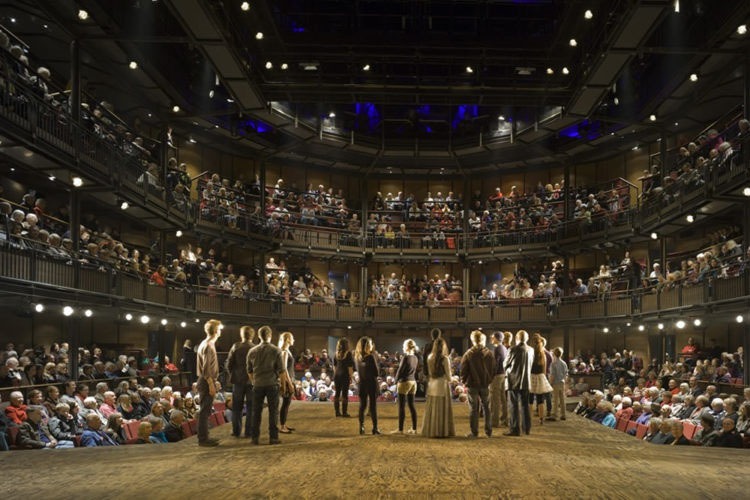 As we already knew, Magic Leap will not rely on technology alone. The recent agreement with the NBA was a very good demonstration. The company also intends to produce, or at least associate with production, content with very high added value. A new example has just been given thanks to the partnership that was signed with the Royal Shakespeare Compan y. For those who do not know, this is one of the most important theater companies in the UK, it exists since the late 19 th century. Among the famous names that have passed on his boards,Gary Oldman has just won an Oscar for The Darkest Hour, Jude Law (Sherlock Holmes), Sir Ian McKellen (The Lord of the Rings) and David Tennant (Doctor Who).
As we already knew, Magic Leap will not rely on technology alone. The recent agreement with the NBA was a very good demonstration. The company also intends to produce, or at least associate with production, content with very high added value. A new example has just been given thanks to the partnership that was signed with the Royal Shakespeare Compan y. For those who do not know, this is one of the most important theater companies in the UK, it exists since the late 19 th century. Among the famous names that have passed on his boards,Gary Oldman has just won an Oscar for The Darkest Hour, Jude Law (Sherlock Holmes), Sir Ian McKellen (The Lord of the Rings) and David Tennant (Doctor Who).
So the link between a high-tech company and a theater company that enters his 3 thCentury? According to the announcements made on March 7, it would simply be a question of reinventing modern theatrical productions. The duo wants to ” look at how space computing can change the way audiences enjoy a theatrical experience .” Specifically, it is a partnership that will allow two graduates of the company to study in Magic Leap as part of a research program. The statement from the Royal Shakespeare Company then goes on to say, “Spatial computing uses technologies that can detect and react to the environment, create a fusion between the real and the digital. Our members will be helped and trained as they research how this technology can be used in real-time performance“
Since the profiles are fundamentally different, we still do not know what kind of training the theater specialists will receive. Magic Leap will not really be able to transform them into augmented or mixed reality specialists in a few months. The idea seems to be rather to pool skills. However, based on the work already done with the NBA in particular, we can have some ideas. This could focus on the use of green funds or production techniques and computer editions. However, this is a very long-term partnership if we believe the ambition shown on both sides. “I am delighted that this journey begins with the opportunity for young people to join us as we explore the possibilities that space computing offers us in the coming years, “concludes Gregory Doran, artistic director of the theater company. The partnership will officially begin in autumn 2018. During the process, the experiences and discoveries will be shared through a blog in collaboration with the Nesta Innovation Foundation.




